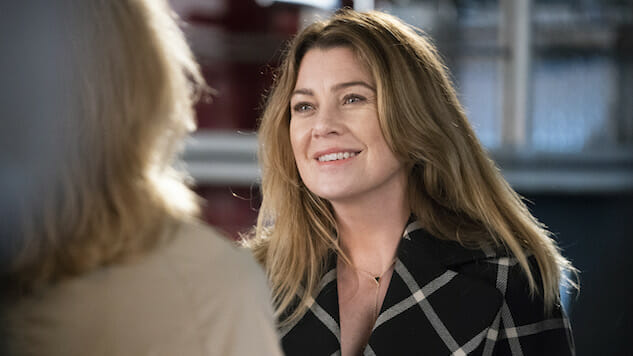The Carousel Never Stops Turning: What I Learned from Watching 15 Seasons of Grey’s Anatomy in 6 Months
Photo: ABC/Eric McCandless
Editor’s note: The following contains spoilers from the first 339 episodes of Grey’s Anatomy.
Time out of mind is time nevertheless, cumulative, informing the present. —Annie Dillard, Pilgrim at Tinker Creek
If Grey’s Anatomy has a central through line, it is, funnily enough, a circle. A carousel, to be precise—the Seattle landmark where esteemed surgeon Ellis Grey (Kate Burton) once watched the love of her life walk out on her, and the symbol at the heart of the wisdom, or warning, she imparts to her daughter: “The carousel never stops turning,” Meredith Grey (Ellen Pompeo), esteemed surgeon in her own right, remembers her mother saying. “You can’t get off.” In the course of 15 seasons, the sentiment has emerged as the unifying theme of Shonda Rhimes’ primetime soap and, after a fashion, its narrative engine: We hear it from Ellis herself, stricken with Alzheimer’s, when she’s admitted to the hospital in Season Two, and then again, repeatedly, in Season 11, near the end of the series’ heyday. If Grey’s Anatomy has a theory of change, an understanding of time, a structuring principle, it’s this notion that there is no escaping life, only riding it out—and the series’ very capaciousness may be its foremost emblem. As of tonight, with its 340th episode, the longest-running medical drama in the history of television is 14 years, one month, and 5 days old, and still its carousel turns, unceasing.
As with so much of the series’ action, I confess that my fixation on this particular image is a function of timing: I came to Grey’s Anatomy belatedly (or, more precisely, returned to it), as research for a piece on the state of the medical drama, and soon found myself obsessed, though not always for the reasons I might’ve expected. To condense the entirety of Grey’s into a span of six months—six months in which I interviewed for, was offered, and accepted a new job, professed my love to a longtime crush (who later kissed me, and then thought better of it), agreed to officiate my brother’s wedding, celebrated the pregnancies of two dear friends and the marriage of two others, ran my first half-marathon (one year after quitting smoking), and marked my 10th Mardi Gras since moving to New Orleans—is to experience a strange accordion effect, a sort of chronological vertigo. For Grey’s itself is life in concentrate: a series so soaked in births, deaths, marriages, divorces, promotions, and relocations, to say nothing of ferry accidents, plane crashes, and live explosives in dying men’s chests, that its ordinary rhythm, its murmuring backdrop, is comprised of heart monitors and No. 10 blades, CT scans and blood work, IV drips, ultrasounds, and sutures in the pit. “The little joys and tragedies that make you who you are have no place in my hospital,” the demanding Dr. Miranda Bailey (Chandra Wilson) announces on this point in Season Four, and for once in her life she’s wrong on both counts. Such joys and tragedies are the very marrow of Grey’s Anatomy, its coursing lifeblood, because they rarely seem so little when they happen to us.
I don’t mean to discount the series’ penchant for dramatics. Its most gripping entries—the aforementioned human bomb, ferry accident, and plane crash; the “John Doe” twist; the patient-turned-attacker; and above all the terrifying shooter-in-the-hospital incident, a two-part episode of such awful gumption it left me shaken, spent—turn on unimaginable crises, acts of God and man for which one cannot prepare. Its most winsome—the Post-It notes and runaway brides; the first kisses and successful surgeries; Meredith winning the Harper Avery as the ghost of her mother looks down from the gallery—turn on unforgettable triumphs, moments for which you spend your days preparing and then astonish you nonetheless. Still, the lion’s share of Grey’s, as of life, occurs in the space around the disasters, between the milestones: Though it may seem to slow down for a spell, the carousel doesn’t stop turning for earthquakes, fires, or ruinous fishing trips; for scientific breakthroughs or candlelight proposals; for miscarriages or heart attacks, adoptions or affairs. Indeed, despite my recent immersion in the series, much of it is already lost to me, though long-ago details occasionally resurface. In Season 14, for instance, a former Seattle Grace nurse named Olivia (Sarah Utterback) reappears for a single episode, and though the focus is on her assessment of reformed asshole Dr. Alex Karev (Justin Chambers), watching it I found myself in a sudden skid down the rabbit hole—to George O’Malley (T.R. Knight) and the “syph nurse” subplot, to his infatuation with Meredith, to the ways in which we hurt others because we are hurt, or hurt ourselves in the false hope that it will win us affection. This is how it always goes: More of your life is forgotten than remembered, until a place, a face, brings it all rushing back.
-

-

-

-

- Curated Home Page Articles By Test Admin October 21, 2025 | 3:10pm
-

- Curated Home Page Articles By Test Admin October 21, 2025 | 2:57pm
- Urls By Test Admin October 21, 2025 | 2:57pm
- Curated Home Page Articles By Test Admin October 21, 2025 | 2:55pm
-

-

-

-

-

-

-

-

-

-

-

-

-

-

-

-

-

-

-

-

-

-

-

-

-

-

-

-

-

-

-




































